
Summer 1996
FROM PULPSTONES TO BATS
by
Douglas L. Crowell
On a hill west of Empire,
Ohio, overlooking the Ohio River stand many stacks of pulpstones. Some
of these stones are rough cut, and some are finished and look no different
than they did nearly 65 years ago, as if they are still waiting to be shipped.
These silent sentinels are remnants of an unusual mining operation at the
Smallwood sandstone mine in sec. 34, Knox Township, Jefferson County. The
Smallwood mine was operated by the Smallwood Pulp Stone Company and now
is a potential habitat for a community of bats. The Smallwood Pulp Stone
Company had plants at Empire, Ohio, and Opekiska (Monongalia County), West
Virginia, and was the largest producer of pulpstones in the United States
in 1932.
Pulpstones were cut from sandstone strata and manually
shaped into cylinders 4 to 5 feet in diameter and 2 to 4 feet wide (thick).
They are much larger (thicker) versions of grindstones and were used for
grinding wood into fine fiber for making pulp and paper. When paper began
to be manufactured from wood pulp in the mid-1800's, there was a demand
for stone suited to grinding wood to a pulp. The discovery of the method
of mechanically grinding wood to produce pulp is credited to Charles Fennerity
of Halifax, Nova Scotia, in 1844. The first pulp mill using a grinding
wheel was built in 1846 by H. Voelter.
Most pulpstones were imported from Newcastle-upon-Tyne,
England, until Ohio began supplying these stones in the late 1800's. Grindstones
have diameters similar to pulpstones but are typically only 8 to 12 inches
wide. Grindstones originally were used for sharpening tools. During the
late 1800's, Ohio's grindstones were popular in finish grinding of metals
prior to polishing or painting. Ohio has supplied about 90 percent of the
4.5 million tons of grindstones consumed in the United States. Although
pulpstones were produced in Ohio during the late 1800's, production data
were not reported until 1903. From 1903 to 1916, Ohio supplied between
82 and 90 percent, by value, of the grindstones and pulpstones produced
in the United States.
The object in grinding pulp is to free the fiber in the
wood from its cementing bond of lignin. In 1904, 913,000 tons of
pulp were
ground for use in the production of newsprint paper alone. By 1930, 4,750,000
tons were ground by pulpstone. The standard pulpstones used in the early
1900's to grind 24-inch-wide wood were 54 inches in diameter and had a
24-inch-wide face. Such a stone would weigh about 2.5 tons and required
a power supply of 350 to 450 horsepower per stone to drive. By the 1920's,
the size of pulpstones had increased. To grind 48-inch-wide wood, these
stones were 67 inches in diameter and had a 54-inch face. These stones
weighed about 7.7 tons and required a power supply of 1400 horsepower per
stone to operate. (Note: pulpstone tonnage was calculated, using the formula
for the volume of a cylinder, pi x r2 x h, on the basis of 140
pounds per cubic foot of sandstone.)
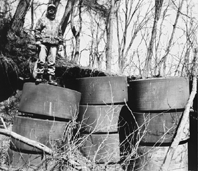
Wendell A. Reese of Empire, Ohio, on top of finished
pulpstones produced at the Smallwood mine at Empire, 1996. |
Grindstones were produced in Washington County, Ohio, as
early as 1819. The first government report on pulpstone production in the
United States was issued in 1898, the same year the Latto quarry at Tippecanoe,
Harrison County, Ohio, was re-opened by the Halderman Stone Company of
Cleveland, Ohio, to produce bridge stone, building stone, grindstones,
and pulpstones. The Latto quarry, developed in the Buffalo sandstone (Pennsylvanian)
in sec. 21, Washington Township, Harrison County, was opened about 1889
by the Tippecanoe Stone Company and was operated by several companies until
it was abandoned in 1907. In addition to these quarries and the Smallwood
mine at Empire, other quarries in Ohio that produced pulpstones include:
-
The Empire Pulp Stone Company of Steubenville, which mined
the Lower Freeport sandstone (Pennsylvanian) in sec. 35, Saline Township,
Jefferson County. The sandstone in this quarry is uniformly coarse grained,
contains little mica, and is cemented in part by iron oxide. This quarry
was abandoned about 1923.
-
The Smallwood-Low Stone Company of Lisbon, which mined the
Lower Freeport sandstone in sec. 14, Center Township, Columbiana County.
About 1,500 pulpstones were produced and shipped annually from this quarry,
including exports to Canada and Japan.
-
The General Stone Company of Amherst (Lorain County), which
mined the Buffalo sandstone near Steubenville in sec. 25, Island Creek
Township, Jefferson County. This quarry produced two sizes of pulpstone:
some were 62 inches in diameter and had a 54-inch-wide face, and some were
54 inches in diameter and had a 27-inch-wide face. Some of these pulpstones
were shipped to Canada. This quarry employed 30 to 40 men.
-
The International Pulp Stone Company of Elyria (Lorain County),
which mined the Lower Freeport sandstone at California Hollow near East
Liverpool in sec. 24, Liverpool Township, Columbiana County. The California
Hollow quarry opened in the early 1900's and employed between 40 and 50
workers. It was abandoned in the 1930's. This company also operated a pulpstone
quarry near Hammondsville, Jefferson County.
Although Ohio was a national leader in the production of
grindstones and pulpstones, it is the way the sandstone was mined at the
Smallwood mine that is unusual.
SANDSTONE MINING
Pulpstones and grindstones in Ohio generally were produced
at quarries by surface mining methods. However, the pulpstones of the Smallwood
Pulp
Stone Company at Empire were produced by both surface and underground mining
methods. The Smallwood Pulp Stone Company began surface mining sandstone
at Empire about 1914, possibly as early as 1906. By 1917 the U.S. Geological
Survey reported that the Smallwood
Pulp Stone Company had active quarries
at both Empire, Ohio, and Opekiska, West Virginia. The sandstone produced
at the Empire mine is the Upper Freeport sandstone. This Pennsylvanian-age
sandstone is about 70 feet thick and was deposited by rivers that meandered
back and forth across the area. The sandstone lies about midway in the
steep-sided hills west of Empire.
Once the overburden at the Smallwood mine was removed,
a coal-fired, compressed-air channeling machine cut the sandstone into
blocks 20 feet square and 10 to 12 feet thick. The channeling machine could
cut a groove about 3 inches wide and 10 to 12 feet deep into the sandstone,
using chisel-like teeth. Channeling machines were developed in the 1880's
and replaced hand cutting of the grooves. The use of a channeling machine
was common among northern Ohio sandstone quarry operators. Sandstone quarry
operators in southern Ohio used machines called ditchers to cut circle-shaped
grooves in sandstone. This machine, also developed in the 1880's, used
a channeler or drill that revolved around a fixed, vertical post.
After the outline of the sandstone block was cut, holes
were drilled at the base of the block. Explosive charges sufficient to
crack the sandstone were placed in the holes and detonated. The sandstone
blocks were split to desired sizes by additional drilling and blasting.
The removal of sandstone created a highwall. As mining continued the highwall
advanced farther into the hillside until an overburden thickness of about
60 feet was reached. At this point, the removal of overburden material
was too costly and difficult, and normally the mining operation would be
abandoned. However, the Smallwood Pulp Stone Company continued their operation
at Empire by tunneling into the Upper Freeport sandstone and mining it
underground.
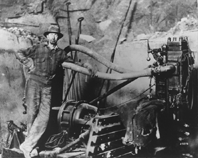
Quarryman next to a channeling machine used inside the
Smallwood mine. Circa 1920's. Photo courtesy of Wendell B. Reese. |
Around 1920, three drift openings were made into the sandstone
by Smallwood employees Charles and James Vance. These drift openings measure
about 30 feet wide and 25 feet tall and extend into the hill approximately
150 feet before joining an entryway that runs parallel to the crop of the
sandstone. The sandstone apparently was mined by room-and-pillar style
of mining; room height was nearly equal to the full thickness of the sandstone.
Steel I-beams were used to span the entryways to provide roof support in
addition to the sandstone pillars. According to an inventory form on file
at the Ohio Historic Preservation Office of the Ohio Historical Society,
some of the I-beams were removed from the mine during World War II and
sold as scrap iron.
The Upper Freeport sandstone at the Smallwood mine was
mined underground by the same channeling machines that were used to mine
the sandstone at the surface. Sandstone blocks produced underground were
split to size and then brought to the surface by mine car for finish work.
PULPSTONE PREPARATION
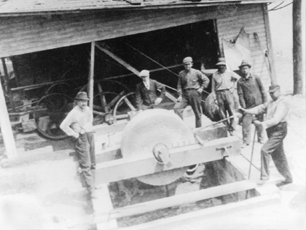
Part of the yard crew around a lathe at the Smallwood
mine at Empire. As the stone revolved in the lathe, steel bars were held
against the stone to give it a smooth, circular surface. Circa 1920's.
Photo courtesy of Wendell B. Reese. |
The first stage in finishing a pulpstone was to cut off the
corners of the sandstone blocks, a process called "scabbling," using compressed-air
tools to produce a stone with a cylindrical shape. Next, a square or round
eyehole 4 to 5 inches in diameter was cut through the center of the stone.
The eyehole allowed the stone to be placed on a shaft of a lathe. As the
stone was turned on the lathe, iron rods resembling crowbars were held
against the stone to machine a smooth, rounded edge.
The finished pulpstones at the Smallwood mine were taken
down the steep hillside by an elaborate, gravity-type tramway. A steel
cable passed around a drum at the top of the incline, a loaded car attached
to one end and an empty car to the other. The empty car ascending the hill
served as a counterbalance to the loaded car descending the hill. The finished
pulpstones were hoisted onto railroad cars and transported to pulp mills
in Michigan, Wisconsin, and Canada.

Stacks of pulpstones and grindstones at the Latto quarry
at Tippecanoe, Harrison County, 1996. |
As the sandstone blocks were mined they were soft and contained
small amounts of water, commonly called "quarry sap." The water generally
drained out of the sandstone within a week or two after having been cut,
but the stone remained somewhat soft. With continued exposure to air the
stone hardened or seasoned, just as concrete hardens with time. This seasoning
process took about a year before the stones were put into service. Freezing
is harmful to fresh-cut pulpstones, therefore pulpstone operators generally
worked from late spring until early fall. In describing winter shipment
of pulpstones, a 1988 report by the Ohio Historical Society stated, "they
[pulpstones] were packed in horse manure to keep [them] from freezing."
The Upper Freeport sandstone was mined underground at
the Smallwood mine until 1932. No production was reported for this mine
after 1931 and no pulpstones were produced in Ohio after 1931. The Smallwood
mine remained idle from 1932 until it was abandoned in 1937. During the
1930's the pulpstone industry in Ohio and nationally was replaced by the
use of artificial abrasives. Artificial pulpstones could withstand the
higher stresses created by modern pulp mills better than natural pulpstones.
The Smallwood mine provided employment to about 40 men,
many of whom spoke little or no English, according to Empire resident Shirley
Bartles. The average annual wages earned by Ohio's sandstone quarrymen
during the period from 1914 to 1931 ranged from $593.40 in 1914 to $1,335.51
in 1927. The average annual wages of sandstone quarrymen compare well with
wages paid to workers producing other mineral commodities. The average
annual wages in 1930 were: $973 to coal miners, $1,090 to clay miners,
$1,182 to sandstone quarrymen, $1,347 to gypsum miners, and $1,400 to limestone
quarrymen. Robert Mattern recalled that as a boy of 14 years old, during
1916, he worked as a general laborer in the quarry at California Hollow
and earned $1.50 per day. Although mining sandstone provided a modest income,
it allowed some to live in relative comfort. On his quarryman's salary
Charlie Vance was able to purchase shoes and clothing for less fortunate
children at Empire in addition to providing for his own four children,
as his granddaughter Shirley Bartles recalled.
BATS
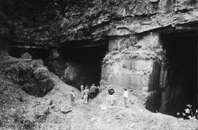
Three drift openings of the Smallwood mine at Empire. The opening at right
measures 25 feet tall and 30 feet wide. Circa 1988. Photo courtesy
of the Ohio Division of Mines and Reclamation. |
When the Smallwood mine was abandoned the drift openings
were not sealed. When any mine is abandoned the roof integrity of the openings
and entryways is not maintained and these areas are not safe to enter.
As a result, abandoned mine openings such as those at the Smallwood mine
become attractive nuisances. Today, abandoned mines are closed for safety
reasons by federal and state governments and mining companies. Permanent
sealing, however, puts at risk bats that use or may use abandoned underground
mines to hibernate, to raise their young, or as a migratory rest stop between
summer and winter roosts. Because of the colonial nature of bats, roosting
habitats need to be large and secure enough and have a proper environment
to accommodate small groups of fewer than a hundred
bats up to large colonies
of several hundred thousand bats. Populations of over 100,000 bats are
known to live in some mines of the northeastern United States and may be
discovered wherever bats live near mines cool enough for hibernation.
Bats hibernate in caves or mines that have a winter temperature
of 38° to 43°F, 65 to 95 percent humidity, and safety from human
disturbance. More than half of North America's bat species use abandoned
mines as a refuge because their roosts in old-growth trees, old barns,
and other outdoor buildings are being lost.
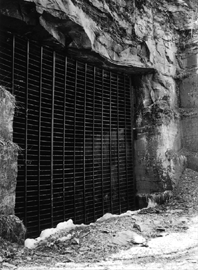
Bat gate covering a drift opening to the Smallwood mine,
1996. This gate allows bats to use the mine as a hibernation site
and prohibits human entry to the mine. |
In a 1995 article, Bob Webster reported some basic bat facts:
bats
are not blind. They won't get stuck in your hair. And, contrary to popular
belief, they seldom transmit diseases such as rabies to humans and animals.
Bats
do, however, eat a lot of insects and help pollinate a variety of plants.
Just one colony of 150 "big brown bats" can catch enough cucumber beetles
each summer to protect local farmers from 18 million of the beetle's rootworm
larva, which cost U.S. growers $1 billion annually.
When the Ohio Department of Natural Resources, Division
of Mines and Reclamation considered sealing the Smallwood drift openings
in 1988, an assessment was made of the site as a potential bat habitat.
Although no bats were documented, the Smallwood mine site was determined
to be an ideal habitat for the endangered Indiana brown bat as well as
other native species. In 1991, a bat gate was erected over each drift opening
to permit bat entry and prohibit human entry to the mine. Similar assessments
have resulted in 20 bat gates having been erected between 1986 and 1994
at 12 different abandoned-underground-mine sites in Ohio, including the
Smallwood mine. Additional abandoned-underground-mine sites are being considered
by the Ohio Division of Mines and Reclamation as potential habitats for
bats.
ACKNOWLEDGMENTS
The following individuals provided valuable information
or assistance for this article: Shirley Bartles, Helen Van Dyke, Mary Robinson,
Wendell B. and Wendell A. "Wink" Reese, Sandy Day, Susan Burkett , Mr.
and Mrs. Parker Burkett, Andrew Milarcik, Michael Puskarich, Robert and
Carl Mattern, Steven Gordon, David Simmons, Max Luehrs, James Gue, Hal
Miller, Mark Smith, Jeffrey Reichwein, and David Swanson.
Editor's note: This article is adapted from an article
in the 1995 Report on Ohio mineral industries.
FURTHER READING
Bowles, Oliver, 1917, Sandstone quarrying the United States:
U.S. Bureau of Mines Bulletin 124, 143 p.
Bond, W. B., 1979, Grindstone country: Marietta, Ohio,
privately published, 130 p.
Bownocker, J. A., 1915, Building stones of Ohio: Ohio
Division of Geological Survey Bulletin 18, 160 p.
Bownocker, J. A., and Stout, Wilber, 1928, Mineral industries
of Ohio: Ohio Division of Geological Survey Bulletin 33, 94 p.
Burton, C. J., 1932, Producing pulp stone on a large
scale: The Explosives Engineer, v. 10, p. 63-65.
Condit, D. D., 1912, Conemaugh formation in Ohio: Ohio
Division of Geological Survey Bulletin 17, 363 p.
Cushing, H. P., Leverett, Frank, and Van Horn, F. R.,
1931, Geology and mineral resources of the Cleveland district, Ohio: U.S.
Geological Survey Bulletin 818, 138 p.
Dupuis, D. E., 1942, Forty years progress in pulp stones
and burrs: Pulp and Paper Magazine of Canada, July, p. 558-562.
Lamborn, R. E., 1930, Geology of Jefferson County: Ohio
Division of Geological Survey Bulletin 35, 304 p.
Simmons, D. A., 1991, True grit, Ohio's industrial grindstone:
Timeline (Ohio Historical Society), v. 8, no. 1, p. 40-45.
Stout, Wilber, and Lamborn, R. E., 1924, Geology of Columbiana
County: Ohio Division of Geological Survey Bulletin 28, 408 p.
Tuttle, M. D., and Taylor, D. A. R., 1994, Bats and mines:
Bat Conservation International, Inc., Resource Publication No. 3, 41 p.
Webster, Bob, 1995, Bats call old mines home: Mining
Voice, v. 1, no. 5, p. 33-35.
|





